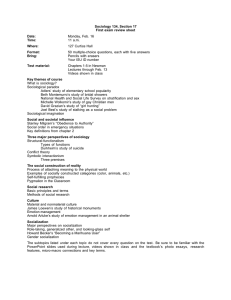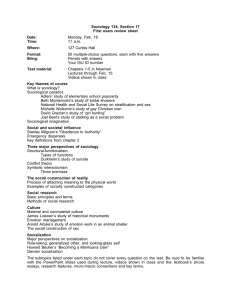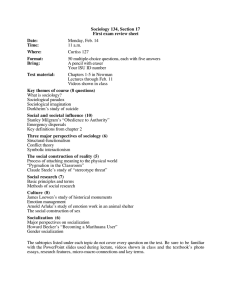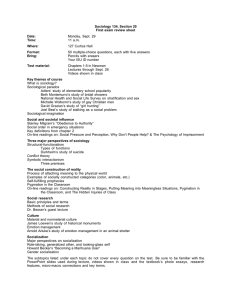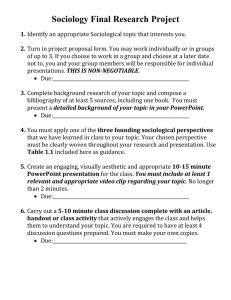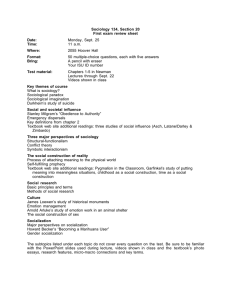After your registration is complete and your proctor has been... Credit by Examination for Sociology. To the Student:
advertisement
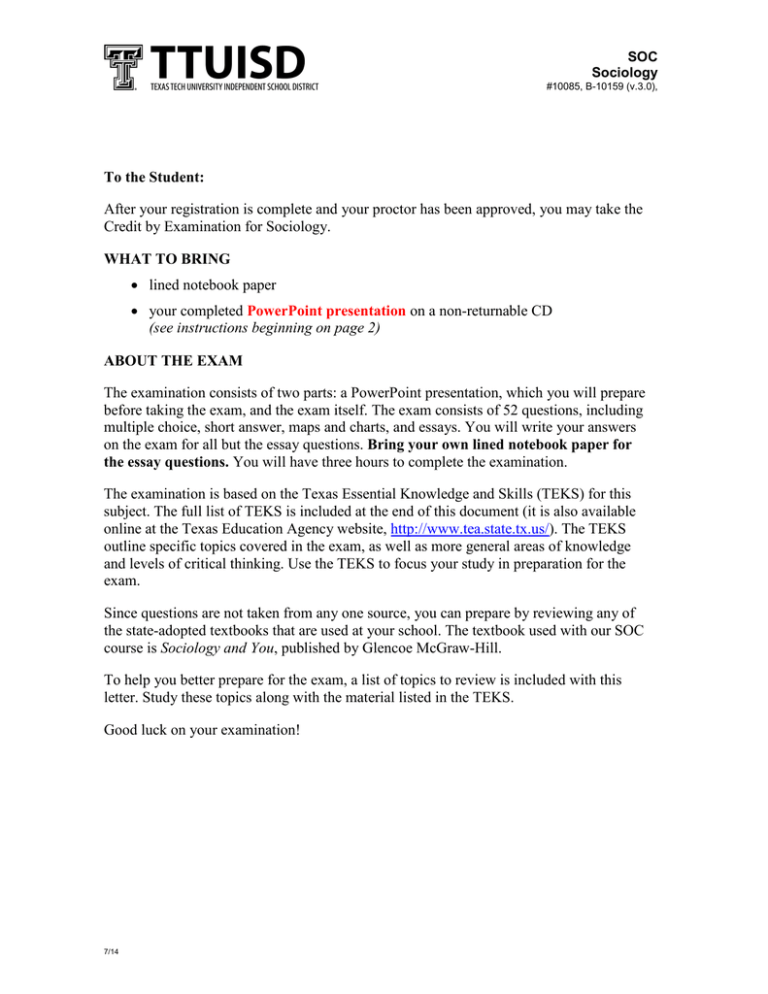
SOC Sociology #10085, B-10159 (v.3.0), To the Student: After your registration is complete and your proctor has been approved, you may take the Credit by Examination for Sociology. WHAT TO BRING • lined notebook paper • your completed PowerPoint presentation on a non-returnable CD (see instructions beginning on page 2) ABOUT THE EXAM The examination consists of two parts: a PowerPoint presentation, which you will prepare before taking the exam, and the exam itself. The exam consists of 52 questions, including multiple choice, short answer, maps and charts, and essays. You will write your answers on the exam for all but the essay questions. Bring your own lined notebook paper for the essay questions. You will have three hours to complete the examination. The examination is based on the Texas Essential Knowledge and Skills (TEKS) for this subject. The full list of TEKS is included at the end of this document (it is also available online at the Texas Education Agency website, http://www.tea.state.tx.us/). The TEKS outline specific topics covered in the exam, as well as more general areas of knowledge and levels of critical thinking. Use the TEKS to focus your study in preparation for the exam. Since questions are not taken from any one source, you can prepare by reviewing any of the state-adopted textbooks that are used at your school. The textbook used with our SOC course is Sociology and You, published by Glencoe McGraw-Hill. To help you better prepare for the exam, a list of topics to review is included with this letter. Study these topics along with the material listed in the TEKS. Good luck on your examination! 7/14 SOC Exam Prerequisite Research Design in Sociology, PowerPoint Project Introduction For this project, you will select a contemporary topic of sociological study and plan an approach to studying it. You will not be expected to conduct the actual study, but you will need to go through the steps that lay the groundwork for successful inquiry. You will pretend that you are a sociologist writing a proposal that will help you get funding to conduct your research. You will turn in a 4-5 page document that presents the first five steps below. You will also turn in a PowerPoint presentation (step 6) that summarizes your proposal document and that will show an audience why your research project should be funded. Print your document, and save your PowerPoint presentation onto to a non-returnable CD or DVD. Bring these two items with you to the exam, and give them to the proctor. Project Steps 1. Identify a topic or object of study. Write a short description of your topic, and explain why you chose it. 2. Conduct a literature review. This means you must find out all you can about previous research that has been done on this topic. Make a note of how you located each resource (online index, library search, etc). For at least one source, write a 2-3 sentence summary on the important information in the source. This could include the research methods used, the conclusions reached, or any other information that could influence how you approach your own research. 3. Formulate a hypothesis. Based on what you know about your topic, write a statement about your topic that can be tested by research. 4. Develop a plan of research. How will you go about testing your hypothesis? Your approach should include at least one of the following tools: • a survey • interview questions • a field observation form (a form you would use to document observations you might make in the field) 5. What will you do with the data when you have finished collecting it? Will you use percentages or other statistical methods? Make a sample of the kind of graphs or charts you think you might use to present your data. 2 6. Create a PowerPoint presentation. Your presentation must include both text and graphics. Create charts, graphs, maps, illustrations, or generate other graphics based on information you find in your literature review for the purpose of strengthening your proposal. For example, you may take statistical data that you find in an article and create a chart or graph based on that data. You may also use relevant photographs that you find during your literature review. These graphics should support the need for further study or demonstrate a foundation for your study. Practice “word economy” in each slide. Textual information should be informative, but to the point. Write speaking notes that accompany each slide. Slides should be eye-catching, but always relevant. 7. Present your printed proposal and PowerPoint project on a non-returnable CD or DVD. Evaluation Your project will be scored based on the following: • completion of all six steps; • clarity of the summary of the topic of study; • demonstrated understanding of a literature review and its purpose; • ability to select relevant sources for the literature review; • ability to formulate a clear, testable hypothesis; • ability to create a quality tool for conducting research (For example, are the questions you ask relevant and useful? Or does your field observation form help you collect the right kind of data?); • understanding of the methods used for analyzing data; • understanding of how data from research may be presented; and • quality of the PowerPoint presentation you create. continued → 3 Preparing for the Exam To successfully prepare for the exam, the general areas you need to be familiar with are: • sociological terminology; • critical thinking skills to help organize and use information acquired from a variety of sources; • the steps of decision-making process using a current issue facing adolescents; • explain how society norms differ from the realities of scientific research; • explain why sociology is a social science; • explain the basic principles of the functional perspective, the conflict perspective, and the symbolic interaction perspective; • explain the steps sociologists use to guide their research; • know how to use a computer for research; • compare and contrast sociological information; The specific areas you need to be familiar with are: Sociological Perspective and Research • describe what led to the development of the field of sociology; • identify leading sociologists in the field of social science as well as their contributions to the field; • list the standards for proving cause-and-effect relationships; Culture and Socialization • identify at least two examples of subcultures and countercultures and then describe what makes them unique (include factors such as stereotyping, social problems, and cultural normal that impact their society); • identify, describe, and analyze at least two types of societies and their cultural life as it exists in the world today; • identify agents of socialization; • identify major elements of culture; • identify types of mass media; • identify some ramifications of stereotyping; continued → 4 Social Structure and Groups • describe types of societies such as hunting and gathering, agrarian, pastoral, industrial, and post-industrial; • describe models of primary, secondary, formal, informal, and reference groups and e-communities; • analyze groups in terms of membership roles, status, values, mores, role conflicts, and methods of resolution; • explain how U.S. institutions and society has changed due to industrialization, urbanization, and immigrant assimilation; Deviance and Social Control • compare/contrast information regarding how crime statistics are gathered; • identify approaches used by the criminal justice system in the U.S. to control crime and deviant behavior Social Stratification • describe characteristics and components of caste and class systems and social mobility; then talk about how motivation affects each; • define poverty and its components; describe poverty’s impact on the individual and society; • contrast theories of social stratification between the U.S. and India; Inequalities • define race, ethnicity, and minority; • distinguish between prejudice and discrimination; • identify various treatment patterns of minority groups; • identify instances of institutional racism in American society; • examine how gender roles affect the opportunities available to men and women in society; • identify the effects of aging in our society; Social Institutions • identify the major sociological institutions and their functions; • describe political institutions in terms of the nature of power and authority; • identify different types of government; • differentiate between free enterprise and socialism; • identify the types of mass media in the United States; 5 • identify how mass media affects the major sociological institutions; • identify characteristics of the family, including marriage patterns, family disruption, and current trends; • identify traditional work roles and working conditions of children, women, and the elderly; compare these to the roles and working conditions of these groups today; • argue or defend a current issue in American education; • describe the functionalist, conflict, and the interactionist perspectives of education; • describe the sociological perspective on religion; • compare and contrast religion in the United States to at least two other societies (within the United States or with other countries); The Changing Social World • define population; • identify three population processes; • describe how technology, population, natural environment, revolution, and war cause culture to change; You will also need to know the definitions of the following terms: • sociology • informal organization • functionalist perspective • primary group • conflict perspective • secondary group • interactionist perspective • racial minority • median • ethnic minority • dependent variable • subculture • independent variable • prejudice • conflict resolution • stereotype • population • ageism • reference group • sexism • socialization • infant mortality rate • formal organization 6 Texas Essential Knowledge and Skills SOC: Sociology TEKS: §113.37. Sociology (One-Half Credit) §113.37. Sociology (One-Half Credit). (a) General requirements. Students shall be awarded one-half unit of credit for successful completion of this course. (b) Introduction. In Sociology, an elective course, students study dynamics and models of individual and group relationships. Students study topics such as the history and systems of sociology, cultural and social norms, social institutions, and mass communication. (c) Knowledge and skills. (1) Citizenship. The student understands that individuals require knowledge of the dynamics of the relationships between self and others to be contributing members of the community. The student is expected to: (A) describe models of group systems and the interactive roles of individuals, groups, and the community; and (B) evaluate role conflicts and methods of resolution that may occur among individuals and groups. (2) Citizenship. The student analyzes groups in terms of membership roles, status, values, and socioeconomic stratification. The student is expected to: (A) compare the roles of group membership in various formal and informal groups; and (B) compare the roles of group membership in selected primary and secondary groups. (3) Economics. The student understands how socioeconomic stratification affects human motivation. The student is expected to: (A) analyze the relationship between socioeconomic stratification and human motivation; and (B) analyze the influence of different motivations and aspirations on economic decisions. (4) Economics. The student understands the relationship between socioeconomic stratification and cultural values. The student is expected to: (A) compare cultural values associated with socioeconomic stratification; and (B) analyze and explain the influence of cultural values on economic behavior. (5) Geography. The student uses geographic tools to collect, analyze, and interpret sociological data. The student is expected to: (A) create thematic maps, graphs, charts, models, and data bases that represent various aspects of demographic and cultural patterns; and (B) pose and answer questions about geographic distributions and demographic and cultural patterns shown on maps, graphs, charts, models, and databases. (6) Geography. The student understands that socialization, cultural values, and norms vary in different geographic places and regions. The student is expected to: (A) compare socialization in selected regions of the United States; and (B) compare how geographic considerations have influenced the development of cultural values and norms. (7) Government. The student understands how governments promote cultural values and provide for social controls. The student is expected to: (A) identify the relationships between cultural values and the purposes and policies of government; and (B) describe types of government social controls. (8) Government. The student understands different styles and forms of leadership, political socialization, and communication techniques that influence perception, attitudes, and behavior. The student is expected to: (A) identify and describe different forms of leadership as they relate to group-motivation techniques; (B) analyze the relationship among social class, racial, ethnic, and other culture group membership, and political power in the United States; and (C) evaluate different communication techniques, including propaganda and advertising, used to influence perceptions, attitudes, and behaviors of persons and groups. 7 (9) History. The student understands the theoretical perspectives of the historic interpretations of human social development. The student is expected to: (A) trace the development of the field of sociology; and (B) identify major sociologists and explain their contributions to the field. (10) History. The student understands the causes and effects of social and institutional changes. The student is expected to: (A) evaluate changes in U.S. institutions resulting from industrialization, urbanization, and immigrant assimilation; and (B) analyze changes such as those in advertising, food, and business in the majority U.S. culture resulting from adaptations to various immigrant and Native-American cultures. (11) History. The student understands basic sociological principles related to change within a group and across groups. The student is expected to: (A) relate theories of change to major changes in U.S. public policy such as the origins and consequences of the civil rights movement; and (B) analyze social change and resulting social problems within and across groups. (12) Culture. The student understands how cultural socialization, norms, values, motivation, and communication influence relationships among groups. The student is expected to: (A) compare cultural norms among various U.S. subculture groups such as ethnic, national origin, age, socioeconomic strata, and gender groups; (B) describe stereotypes of the various U.S. subcultures; and (C) analyze social problems in selected U.S. subcultures. (13) Culture. The student understands how people develop social institutions to meet basic needs in a society. The student is expected to: (A) summarize the functions of social institutions such as the family, religion, and education; and (B) evaluate the importance of social institutions in the United States. (14) Social studies skills. The student applies critical-thinking skills to organize and use information acquired from a variety of sources including electronic technology. The student is expected to: (A) create a product on a contemporary sociological issue or topic using critical methods of inquiry; (B) analyze information by sequencing, categorizing, identifying cause-and-effect relationships, comparing, contrasting, finding the main idea, summarizing, making generalizations and predictions, and drawing inferences and conclusions; and (C) use appropriate mathematical skills to interpret sociological information. (15) Social studies skills. The student communicates in written, oral, and visual forms. The student is expected to: (A) use sociology-related terminology correctly; (B) use standard grammar, spelling, sentence structure, and punctuation; (C) transfer information from one medium to another, including written to visual and written or visual to statistical, using computer software as appropriate; and (D) create written, oral, and visual presentations of social studies information. (16) Social studies skills. The student uses problem-solving and decision-making skills, working independently and with others, in a variety of settings. The student is expected to: (A) use a problem-solving process to identify a problem, gather information, list and consider options, consider advantages and disadvantages, choose and implement a solution, and evaluate the effectiveness of the solution; (B) use a decision-making process to identify a situation that requires a decision, gather information, identify options, predict consequences, and take action to implement a decision; and (C) participate in conflict resolution using persuasion, compromise, debate, and negotiation. (17) Science, technology, and society. The student understands the impact of scientific discoveries and technological innovations on individuals and societies. The student is expected to: (A) analyze how individual and societal behavior has changed as a result of scientific discoveries and technological innovations; and (B) predict societal changes resulting from innovations in science and technology. 8 (18) Science, technology, and society. The student understands the impact of changes in science and technology on moral and ethical issues. The student is expected to: (A) analyze how the norms and behaviors of a selected U.S. subculture group have changed as a result of changes in science and technology; and (B) evaluate a current ethical issue that has resulted from scientific discoveries and/or technological innovations. Source: The provisions of this §113.37 adopted to be effective September 1, 1998, 22 TexReg 7684. 9
